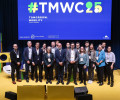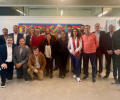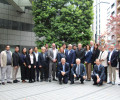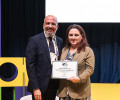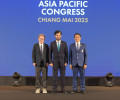AUTO #15 HELP IS AT HAND
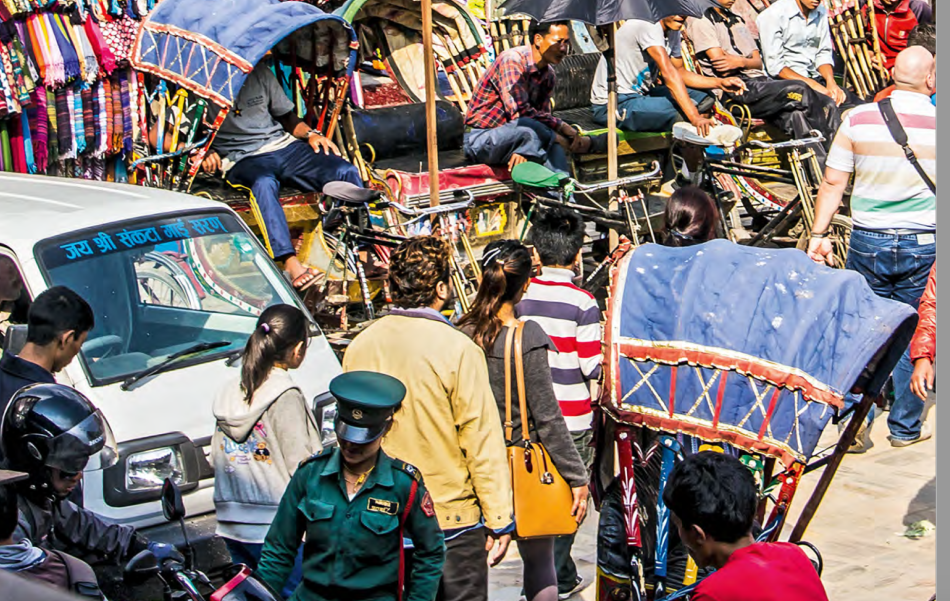
The FIA has two pillars – Mobility and Sport – charged with the development of safe, clean and fair motoring and motor sport around the world. To support the goals of each pillar, the Federation has initiated dedicate grant programmes designed to bring about change.
On the world’s roads the battle to improve safety is one conducted on many fronts. At its most elevated it involves building the political will to drive through change at governmental level. However, beyond the rarefied confines of parliamentary chambers the impact is most acutely felt at grassroots level, in campaigning to change hearts and minds on the roads where some 1.3 million people are killed each year.
In 2013, for example, in conjunction with the World Health Organisation, action took place in a host of locations deemed to be among the most dangerous for pedestrians. From Rome to Santiago, from Minsk to Brussels and through campaigns in countries such as India, Israel, Moldavia and Nigeria, road safety initiatives staged as part of the United Nations Global Road Safety Week targeted those who tackle roads on foot.
The programmes are as diverse as the issues that demand action. In Bogota, FIA member club the Automobile Club de Colombia constructed a ‘Pedagogic City Traffic Park’ to raise awareness among schoolchildren about safety for all road users. The ‘park’ was visited by over 100 schools for a day of road education and the activity contributed to a 71 per cent drop in road accidents among under 17s, according to estimates from the Bogota Mobility Department.In Germany, one of the world’s largest motoring organisations, the Allgemeiner Deutscher Automobile-Club (ADAC), established a training programme and an action plan for fire service and ambulance crews who respond to road traffic accidents. The programme was then also implemented by fellow FIA memberclubs in Austria, France, Switzerland, Spain and Romania. Meanwhile, in Nepal, a road safety awareness campaign aimed at children, set up by the Nepalese Automobile Sports Association, reached more than 150,000 youngsters.Twenty more programmes are being created in 2016 to provide a practical follow-up to the UN’s #SaveKidsLives campaign, co-ordinated by the United Nations Road Safety Collaboration, aimed at reaching a target of a million signatures in support of the Child Declaration for Road Safety.These are just a few examples of projects set up in the past or in the current year thanks to the FIA Road Safety Grant Programme, established in 2012 and still operational today.
The programme was established to support the 2011-2020 Decade of Action for Road Safety, created by the United Nations General Assembly in a resolution voted through by over 100 countries on 11th May 2011, and thanks to funding from the FIA Foundation, more than 200 projects have been created in over 70 countries, with a total budget in excess of €4 million.“By offering the opportunity to apply for the Road Safety Grant Programme, the FIA supports its members in their various efforts to improve road safety measures around the world. From Peru to Poland, from Tanzania to India, the FIA Road Safety Grant Programme calls for a collective approach among FIA clubs to solve existing road safety issues,” explains Andrew McKellar, FIA Secretary General Automobile Mobility and Tourism.“The programme not only connects creative initiatives to financial resources, but it also ensures that every safety outcome is measured through specific safety targets,” he adds. “Most importantly, results and lessons learned are shared across the entireFIA network to further mobilise actions for road safety. The Road Safety Grant Programme is a way to unite mobility stakeholders and make progressive steps towards a future where every journey is a safe one.” The UN Decade of Action’s structure of tackling improvement across five pillars – capacity building, safe vehicles, safe infrastructure, safe road users, and post-crash intervention – is mirrored by the activities of the FIA Grant Mobility Programme, with the aim of not only supplying clubs with financial assistance but also the necessary know-how to implement activities that not only heighten public awareness of road safety, but which also deliver tangible results.
CATERING FOR ALL NEEDS
There are three categories for these projects, divided into Small, Medium and Large. The S-Projects are chiefly concerned with initiatives that support the FIA Action for Road Safety Campaign and the related FIA Golden Rules for Safer Motoring projects, such as media events and promotional campaigns: each project receives up to a maximum of €5000 with an annual budget of €100,000 available. M-Projects can benefit from up to €30,000, to a maximum value of 60 per cent of the cost of each project, with an overall annual budget of €500,000. As for the L-Projects, they are more wide ranging and long-term, promoted by the FIA Programmes Committee and aimed specifically at innovative initiatives in one of the five areas specified by the UN Decade of Actions as requiring collaboration from the clubs. Currently there are two strands being worked on: ‘Child Safety in Cars’, with the development of a device aimed at improving safety for small children in cars, and ‘Road Safety Indicators’, a programme devised in collaboration with the ITF (International Transport Federation) looking at the development of universal indicators for road safety, in order to deliver a better understanding of the problems linked to that and a comparison of the different policies employed in different countries. The associations in involved have a dedicated website available (http://www.roadsafety.fia-grants.com) where they can find all the necessary information relating to budgets. It’s also a window for constant dialogue between the Federation and its members around the world.To understand what these projects are really about and what can be achieved, it’s worth looking at one in greater detail. One of the most successful was one promoted by the AAT (Automobile Association of Tanzania) to establish and implement a road education programme for drivers of the boda-boda, the two- or three-wheeled motorcycle taxis that scurry around the streets of Dar Es Salaam and other major cities of central west Africa, as well as in the countryside in Tanzania, Uganda, Ruanda and Kenya, where they are very often the only form of transport for the overwhelming majority of the population.
The number of accidents involving these vehicles is always high, but there was a significant reduction in the figures in the coastal region of Kibaha, where in 2012 the AAT persuaded over 1000 drivers to attend an educational course relating to road safety. Furthermore, the programme included the distribution of 20,000 fluorescent stickers, which helped improve the visibility of the boda-boda in the hours of darkness.The success of the programme attracted the attention of the authorities in Dar Es Salaam where there are over 20,000 taxis, so that the AAT continued to work on this front, with over 4000 drivers taking part in the course in the city, the biggest in Tanzania. “The response from the drivers was amazing,” confirmed Yusuf Ghor, the AAT CEO. “And this was also thanks to the support of all the authorities involved in the project, starting with the traffic police.”This programme, linked to other similar initiatives, led to a 36 per cent reduction in road accidents in the Dar Es Salaam region in 2015. The Tanzanian government, Tanzania’s National Road Safety Council and various organisations representing the boda-boda drivers asked the AAT not to stop the programme. In its third phase, more than 1000 people were able to tackle a 15-day course, made up of a mix of theory and practical lessons.
Just as the FIA rests on two pillars, mobility and sport, so too the Grant Programme is split into two sections. Alongside initiatives linked to safety campaigns and road education, there exists a parallel FIA Sport Grant Programme, created in 2015. This programme distributes financial support to projects presented by the National Motor Sport Authorities covering four areas of activity: improving safety at motor sport events, supporting the management of governance and structure within the ASN, organisation of grassroots motor sports and action relating to social responsibility. To date, 109 projects have been financed (49 in 2015, 60 so far this year) at a cost of around €4.8 million. “The FIA Sport Grant Programme enables a large number of ASNs to develop motor sport in their countries,” says Jean-Louis Valentin, FIA Secretary General for Sport. “Whether to improve safety, train officials or to structure the administration, this programme provides new opportunities for motor sport and is proving extremely successful. Managed by a specialised Funding Review Commission (FRC) under the chairmanship of the FIA Deputy President for Sport, Graham Stoker, this programme is dedicated to ensuring longevity and strengthening access to motor sport worldwide.”
FUELLING MOTOR SPORT
It’s another case where a practical example shows what can be achieved. In the Philippines, there is great enthusiasm among youngsters for motor sport, but there is no corresponding clearly defined path, or accessible structure for the sport. Therefore, the number of people who give up, either through a lack of preparation or because of ever-growing costs – usually down to all sorts of organisational difficulties – is constantly growing.
The AAP (Automobile Association Philippines) therefore decided to institute a proper training course for youngsters. The programme has seen no fewer than 115 participants tackling a theory and practical course, split into 10 modules. The winner will compete this season in a series of events at regional and national level, including slalom tests, time attack, endurance and one round of the national Touring Car championship. “It’s only thanks to the grant that we have been able to create something that’s never been done before in our country,” says Mark Desales, AAP Motor Sport Department Operations Manager. The project’s request for renewed finance for 2016 has been accepted.
The development by the clubs of basic initiatives is of fundamental importance, especially in countries which do not have a great motor sport tradition. In these instances the Grant Programme can provide the necessary spark to get projects underway. One example of this is ‘EduKarting’, a programme established in 2015 in the Bahamas, thanks to the support of Mexico’s Organización Mexicana De Automovilismo Internacional (OMDAI). The aim is to introduce youngsters from the ages of nine to 17 to motor sport, as well as providing education to ensure they drive responsibly on public roads.
“EduKarting has made a significant contribution to raising awareness of motor sport basics among youngsters in this country,” said David McLaughlin, President and CEO of the Bahamas Motor Sport Association (BMA). “In particular, youngsters from the poorest backgrounds have acquired some understanding of how to drive safely on track and on the roads.” With 100 participants in the first year, the programme has been deemed so successful that the Grant has been continued for 2016. The model for the programme, based on combining karting with elements of road safety education, has proved applicable around the world, as can be seen from the fact that this year it’s been taken up in Mozambique, with the Karting Academy. In this case, not only have 60 children been enrolled, but also a number of parents are taking part. The FIA Grant Programme is a very flexible tool and a new round of applications for 2017 is about to begin, while the FIA and the clubs are evaluating how to work together on even more significant and effective projects, especially on the safety front. These projects have contributed to the promotion of values that are at the heart of the FIA, reinforcing its roots. And, as all good farmers know, the best harvest comes from good seeds.
Click here to read this issue online.

 Facebook
Facebook Twitter
Twitter
